Business and Corporations Law - Assessment 2: Legal Issues Analysis
VerifiedAdded on 2022/09/28
|13
|3393
|33
Homework Assignment
AI Summary
This assignment delves into two primary legal scenarios within the realm of business and corporations law. The first scenario examines a case of potential negligence, exploring the essential elements required to establish negligence, including duty of care, breach of duty, causation, and damages. It references key legal precedents like Grant v Australian Knitting Mills and Donoghue v Stevenson, while also considering defenses against negligence, such as obvious risk and voluntary assumption of risk, drawing upon cases like Froom v Butcher. The second scenario analyzes a contract dispute, focusing on the validity of a contract and the potential for cancellation due to fraudulent misrepresentation. It outlines the essential elements of a valid contract, including offer and acceptance, intention to create legal relations, consideration, and capacity. The assignment examines the concept of fraudulent misrepresentation, referencing cases like Bisset v Wilkinson and Smith v Land and House Property Corporation, and the potential for rescission or damages. The document also discusses the recovery of damages for misrepresentation, referencing Royscot Trust Ltd v Rogerson.
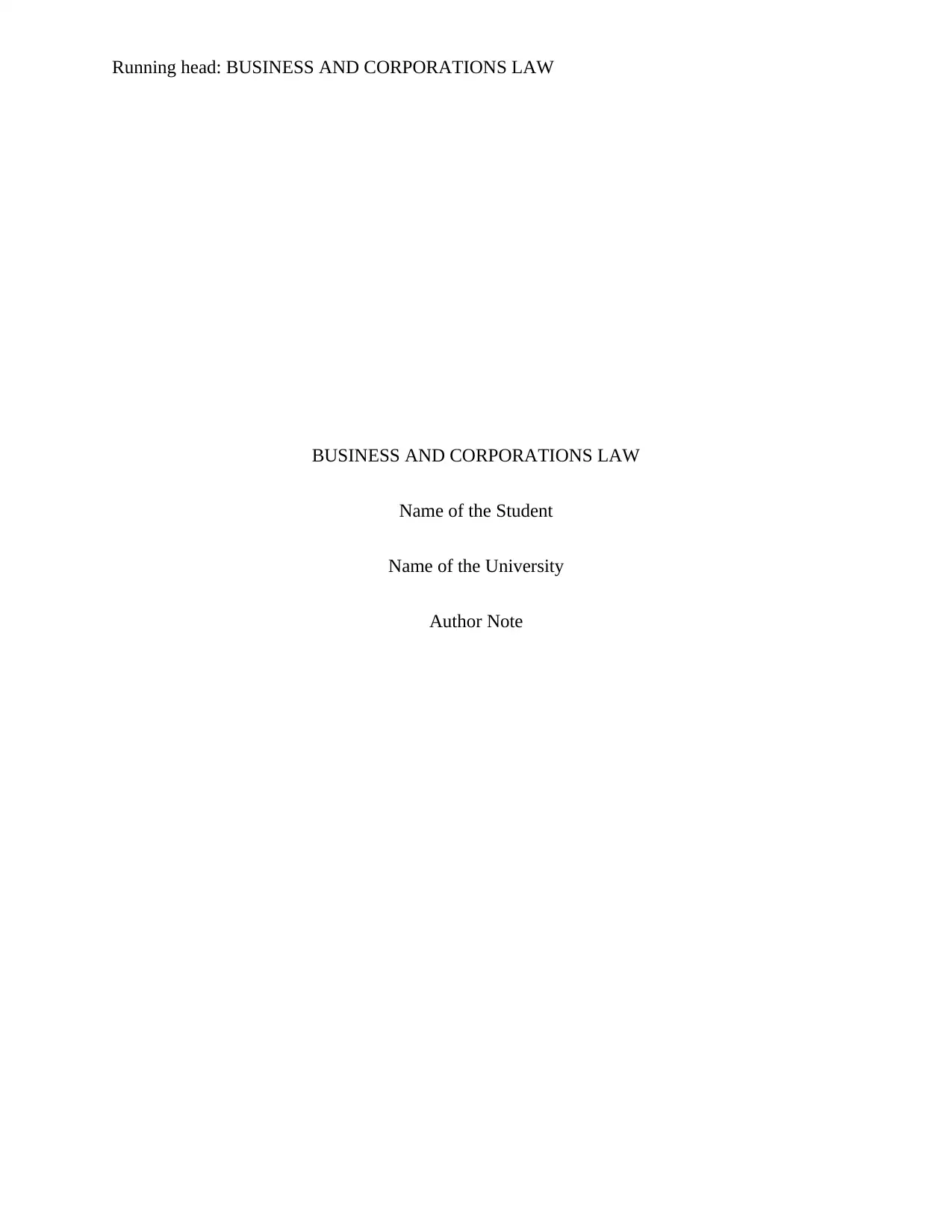
Running head: BUSINESS AND CORPORATIONS LAW
BUSINESS AND CORPORATIONS LAW
Name of the Student
Name of the University
Author Note
BUSINESS AND CORPORATIONS LAW
Name of the Student
Name of the University
Author Note
Paraphrase This Document
Need a fresh take? Get an instant paraphrase of this document with our AI Paraphraser
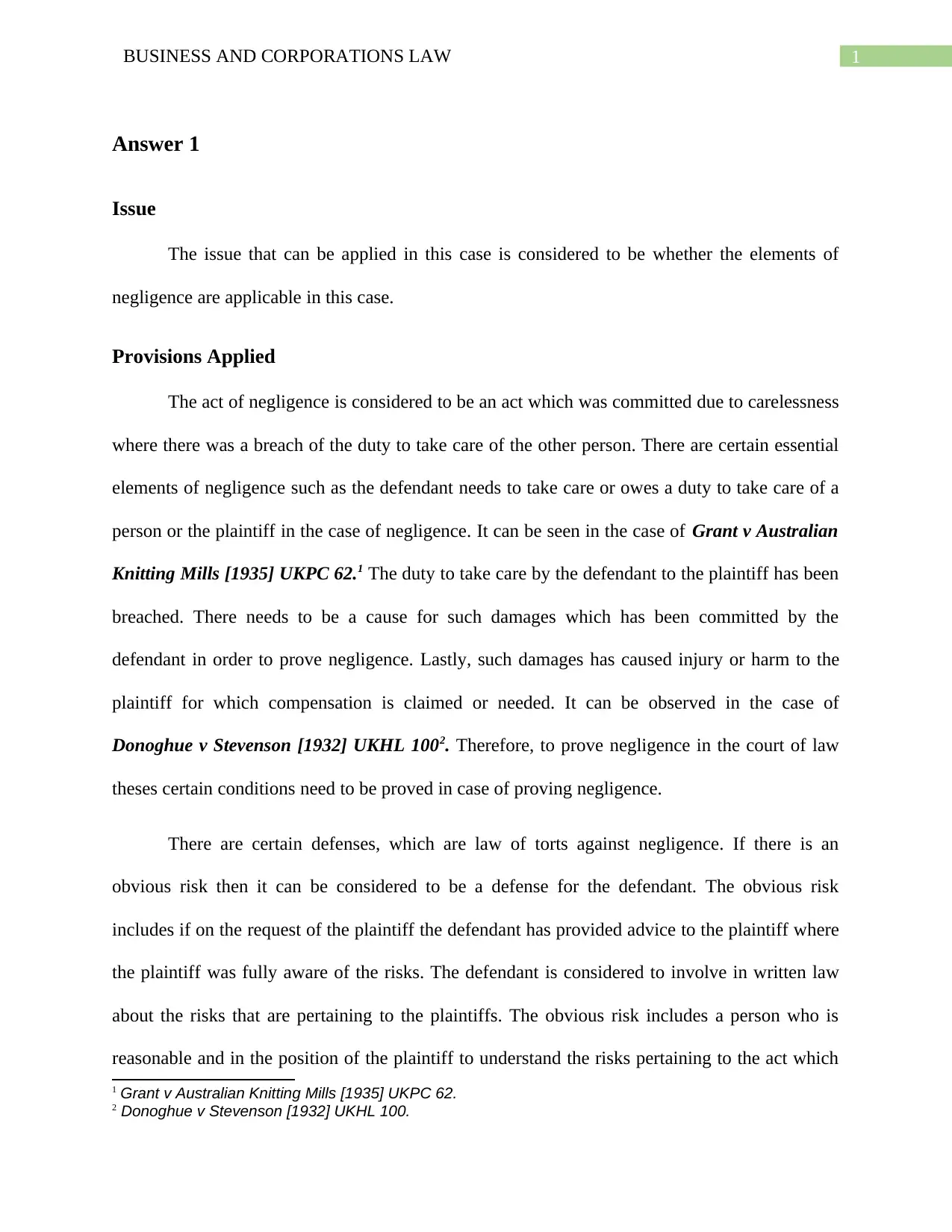
1BUSINESS AND CORPORATIONS LAW
Answer 1
Issue
The issue that can be applied in this case is considered to be whether the elements of
negligence are applicable in this case.
Provisions Applied
The act of negligence is considered to be an act which was committed due to carelessness
where there was a breach of the duty to take care of the other person. There are certain essential
elements of negligence such as the defendant needs to take care or owes a duty to take care of a
person or the plaintiff in the case of negligence. It can be seen in the case of Grant v Australian
Knitting Mills [1935] UKPC 62.1 The duty to take care by the defendant to the plaintiff has been
breached. There needs to be a cause for such damages which has been committed by the
defendant in order to prove negligence. Lastly, such damages has caused injury or harm to the
plaintiff for which compensation is claimed or needed. It can be observed in the case of
Donoghue v Stevenson [1932] UKHL 1002. Therefore, to prove negligence in the court of law
theses certain conditions need to be proved in case of proving negligence.
There are certain defenses, which are law of torts against negligence. If there is an
obvious risk then it can be considered to be a defense for the defendant. The obvious risk
includes if on the request of the plaintiff the defendant has provided advice to the plaintiff where
the plaintiff was fully aware of the risks. The defendant is considered to involve in written law
about the risks that are pertaining to the plaintiffs. The obvious risk includes a person who is
reasonable and in the position of the plaintiff to understand the risks pertaining to the act which
1 Grant v Australian Knitting Mills [1935] UKPC 62.
2 Donoghue v Stevenson [1932] UKHL 100.
Answer 1
Issue
The issue that can be applied in this case is considered to be whether the elements of
negligence are applicable in this case.
Provisions Applied
The act of negligence is considered to be an act which was committed due to carelessness
where there was a breach of the duty to take care of the other person. There are certain essential
elements of negligence such as the defendant needs to take care or owes a duty to take care of a
person or the plaintiff in the case of negligence. It can be seen in the case of Grant v Australian
Knitting Mills [1935] UKPC 62.1 The duty to take care by the defendant to the plaintiff has been
breached. There needs to be a cause for such damages which has been committed by the
defendant in order to prove negligence. Lastly, such damages has caused injury or harm to the
plaintiff for which compensation is claimed or needed. It can be observed in the case of
Donoghue v Stevenson [1932] UKHL 1002. Therefore, to prove negligence in the court of law
theses certain conditions need to be proved in case of proving negligence.
There are certain defenses, which are law of torts against negligence. If there is an
obvious risk then it can be considered to be a defense for the defendant. The obvious risk
includes if on the request of the plaintiff the defendant has provided advice to the plaintiff where
the plaintiff was fully aware of the risks. The defendant is considered to involve in written law
about the risks that are pertaining to the plaintiffs. The obvious risk includes a person who is
reasonable and in the position of the plaintiff to understand the risks pertaining to the act which
1 Grant v Australian Knitting Mills [1935] UKPC 62.
2 Donoghue v Stevenson [1932] UKHL 100.
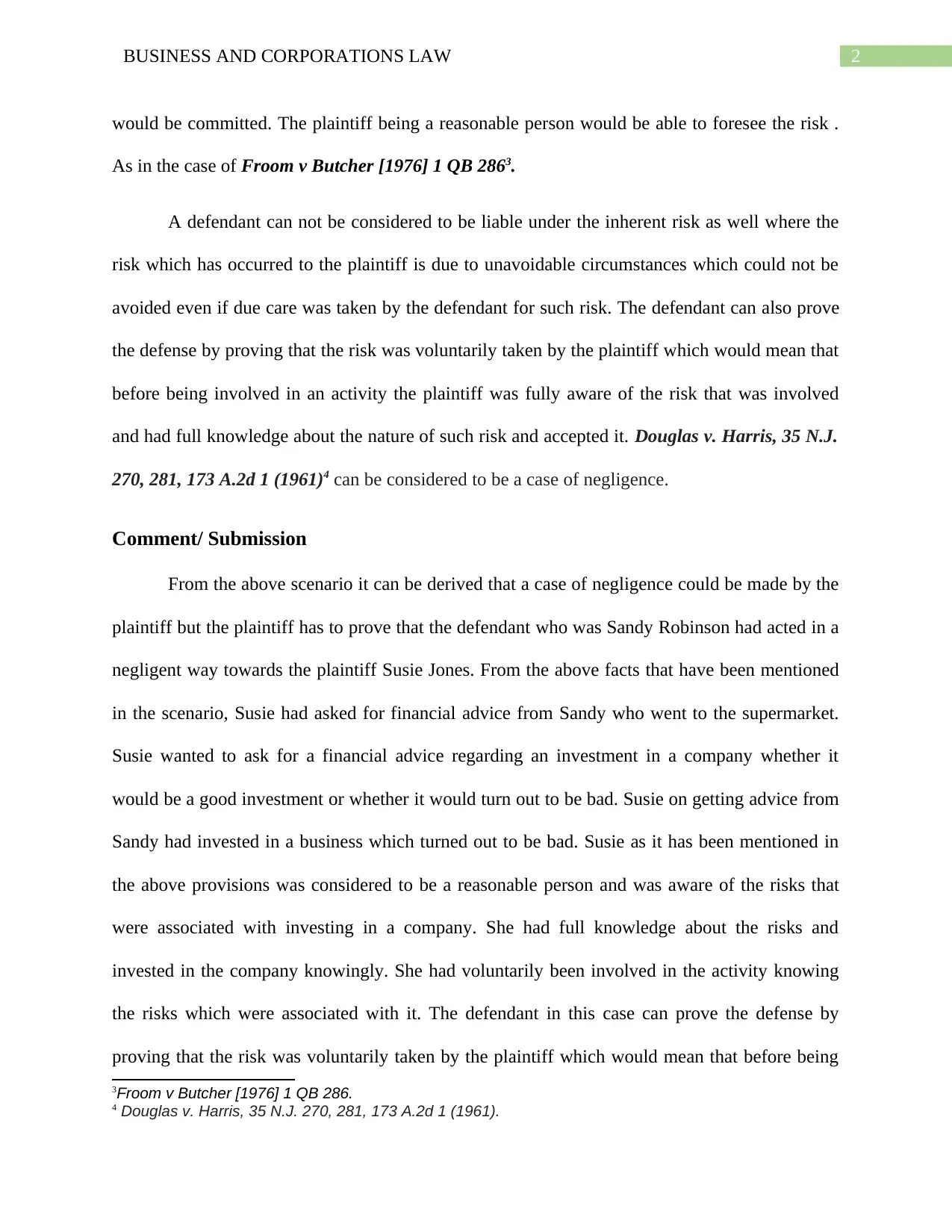
2BUSINESS AND CORPORATIONS LAW
would be committed. The plaintiff being a reasonable person would be able to foresee the risk .
As in the case of Froom v Butcher [1976] 1 QB 2863.
A defendant can not be considered to be liable under the inherent risk as well where the
risk which has occurred to the plaintiff is due to unavoidable circumstances which could not be
avoided even if due care was taken by the defendant for such risk. The defendant can also prove
the defense by proving that the risk was voluntarily taken by the plaintiff which would mean that
before being involved in an activity the plaintiff was fully aware of the risk that was involved
and had full knowledge about the nature of such risk and accepted it. Douglas v. Harris, 35 N.J.
270, 281, 173 A.2d 1 (1961)4 can be considered to be a case of negligence.
Comment/ Submission
From the above scenario it can be derived that a case of negligence could be made by the
plaintiff but the plaintiff has to prove that the defendant who was Sandy Robinson had acted in a
negligent way towards the plaintiff Susie Jones. From the above facts that have been mentioned
in the scenario, Susie had asked for financial advice from Sandy who went to the supermarket.
Susie wanted to ask for a financial advice regarding an investment in a company whether it
would be a good investment or whether it would turn out to be bad. Susie on getting advice from
Sandy had invested in a business which turned out to be bad. Susie as it has been mentioned in
the above provisions was considered to be a reasonable person and was aware of the risks that
were associated with investing in a company. She had full knowledge about the risks and
invested in the company knowingly. She had voluntarily been involved in the activity knowing
the risks which were associated with it. The defendant in this case can prove the defense by
proving that the risk was voluntarily taken by the plaintiff which would mean that before being
3Froom v Butcher [1976] 1 QB 286.
4 Douglas v. Harris, 35 N.J. 270, 281, 173 A.2d 1 (1961).
would be committed. The plaintiff being a reasonable person would be able to foresee the risk .
As in the case of Froom v Butcher [1976] 1 QB 2863.
A defendant can not be considered to be liable under the inherent risk as well where the
risk which has occurred to the plaintiff is due to unavoidable circumstances which could not be
avoided even if due care was taken by the defendant for such risk. The defendant can also prove
the defense by proving that the risk was voluntarily taken by the plaintiff which would mean that
before being involved in an activity the plaintiff was fully aware of the risk that was involved
and had full knowledge about the nature of such risk and accepted it. Douglas v. Harris, 35 N.J.
270, 281, 173 A.2d 1 (1961)4 can be considered to be a case of negligence.
Comment/ Submission
From the above scenario it can be derived that a case of negligence could be made by the
plaintiff but the plaintiff has to prove that the defendant who was Sandy Robinson had acted in a
negligent way towards the plaintiff Susie Jones. From the above facts that have been mentioned
in the scenario, Susie had asked for financial advice from Sandy who went to the supermarket.
Susie wanted to ask for a financial advice regarding an investment in a company whether it
would be a good investment or whether it would turn out to be bad. Susie on getting advice from
Sandy had invested in a business which turned out to be bad. Susie as it has been mentioned in
the above provisions was considered to be a reasonable person and was aware of the risks that
were associated with investing in a company. She had full knowledge about the risks and
invested in the company knowingly. She had voluntarily been involved in the activity knowing
the risks which were associated with it. The defendant in this case can prove the defense by
proving that the risk was voluntarily taken by the plaintiff which would mean that before being
3Froom v Butcher [1976] 1 QB 286.
4 Douglas v. Harris, 35 N.J. 270, 281, 173 A.2d 1 (1961).
⊘ This is a preview!⊘
Do you want full access?
Subscribe today to unlock all pages.

Trusted by 1+ million students worldwide
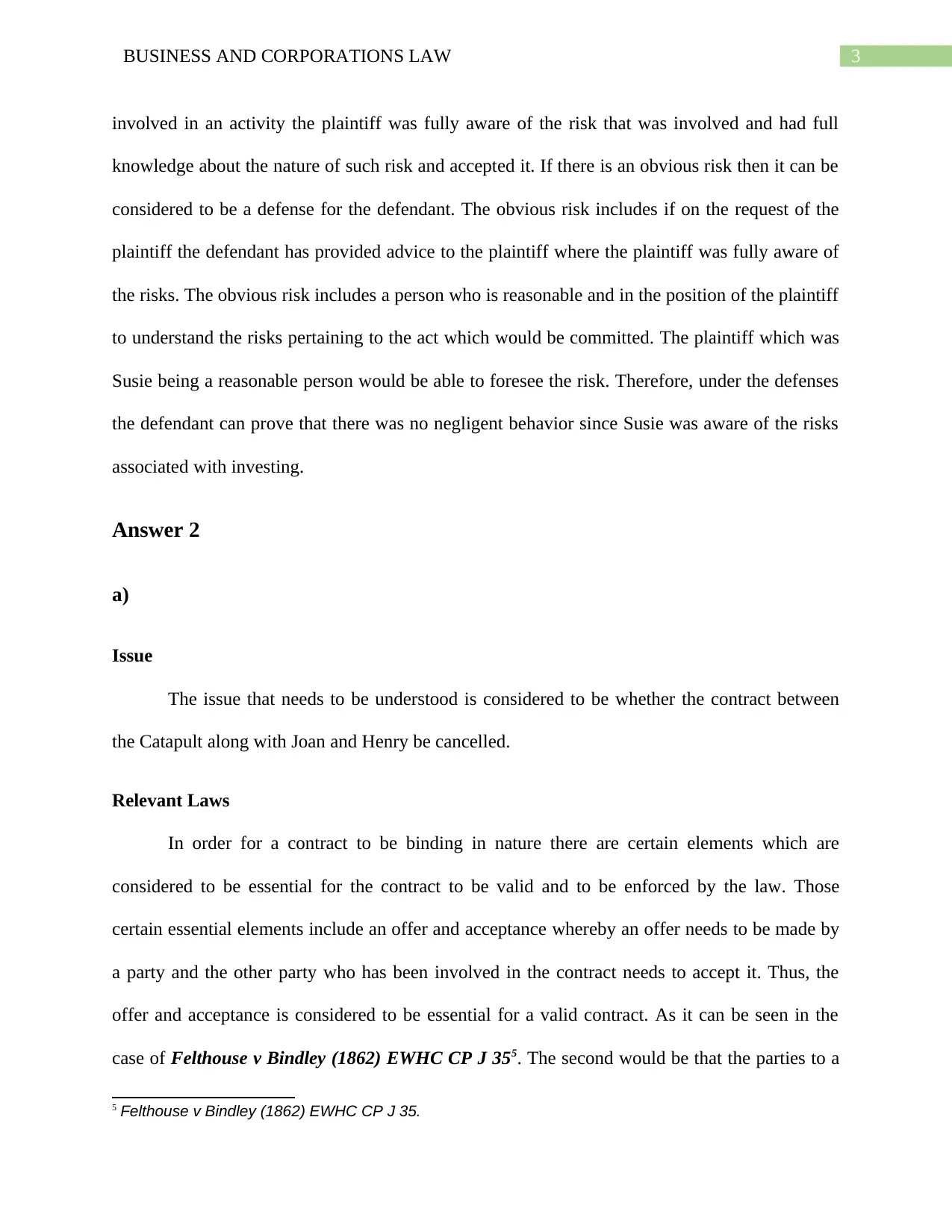
3BUSINESS AND CORPORATIONS LAW
involved in an activity the plaintiff was fully aware of the risk that was involved and had full
knowledge about the nature of such risk and accepted it. If there is an obvious risk then it can be
considered to be a defense for the defendant. The obvious risk includes if on the request of the
plaintiff the defendant has provided advice to the plaintiff where the plaintiff was fully aware of
the risks. The obvious risk includes a person who is reasonable and in the position of the plaintiff
to understand the risks pertaining to the act which would be committed. The plaintiff which was
Susie being a reasonable person would be able to foresee the risk. Therefore, under the defenses
the defendant can prove that there was no negligent behavior since Susie was aware of the risks
associated with investing.
Answer 2
a)
Issue
The issue that needs to be understood is considered to be whether the contract between
the Catapult along with Joan and Henry be cancelled.
Relevant Laws
In order for a contract to be binding in nature there are certain elements which are
considered to be essential for the contract to be valid and to be enforced by the law. Those
certain essential elements include an offer and acceptance whereby an offer needs to be made by
a party and the other party who has been involved in the contract needs to accept it. Thus, the
offer and acceptance is considered to be essential for a valid contract. As it can be seen in the
case of Felthouse v Bindley (1862) EWHC CP J 355. The second would be that the parties to a
5 Felthouse v Bindley (1862) EWHC CP J 35.
involved in an activity the plaintiff was fully aware of the risk that was involved and had full
knowledge about the nature of such risk and accepted it. If there is an obvious risk then it can be
considered to be a defense for the defendant. The obvious risk includes if on the request of the
plaintiff the defendant has provided advice to the plaintiff where the plaintiff was fully aware of
the risks. The obvious risk includes a person who is reasonable and in the position of the plaintiff
to understand the risks pertaining to the act which would be committed. The plaintiff which was
Susie being a reasonable person would be able to foresee the risk. Therefore, under the defenses
the defendant can prove that there was no negligent behavior since Susie was aware of the risks
associated with investing.
Answer 2
a)
Issue
The issue that needs to be understood is considered to be whether the contract between
the Catapult along with Joan and Henry be cancelled.
Relevant Laws
In order for a contract to be binding in nature there are certain elements which are
considered to be essential for the contract to be valid and to be enforced by the law. Those
certain essential elements include an offer and acceptance whereby an offer needs to be made by
a party and the other party who has been involved in the contract needs to accept it. Thus, the
offer and acceptance is considered to be essential for a valid contract. As it can be seen in the
case of Felthouse v Bindley (1862) EWHC CP J 355. The second would be that the parties to a
5 Felthouse v Bindley (1862) EWHC CP J 35.
Paraphrase This Document
Need a fresh take? Get an instant paraphrase of this document with our AI Paraphraser
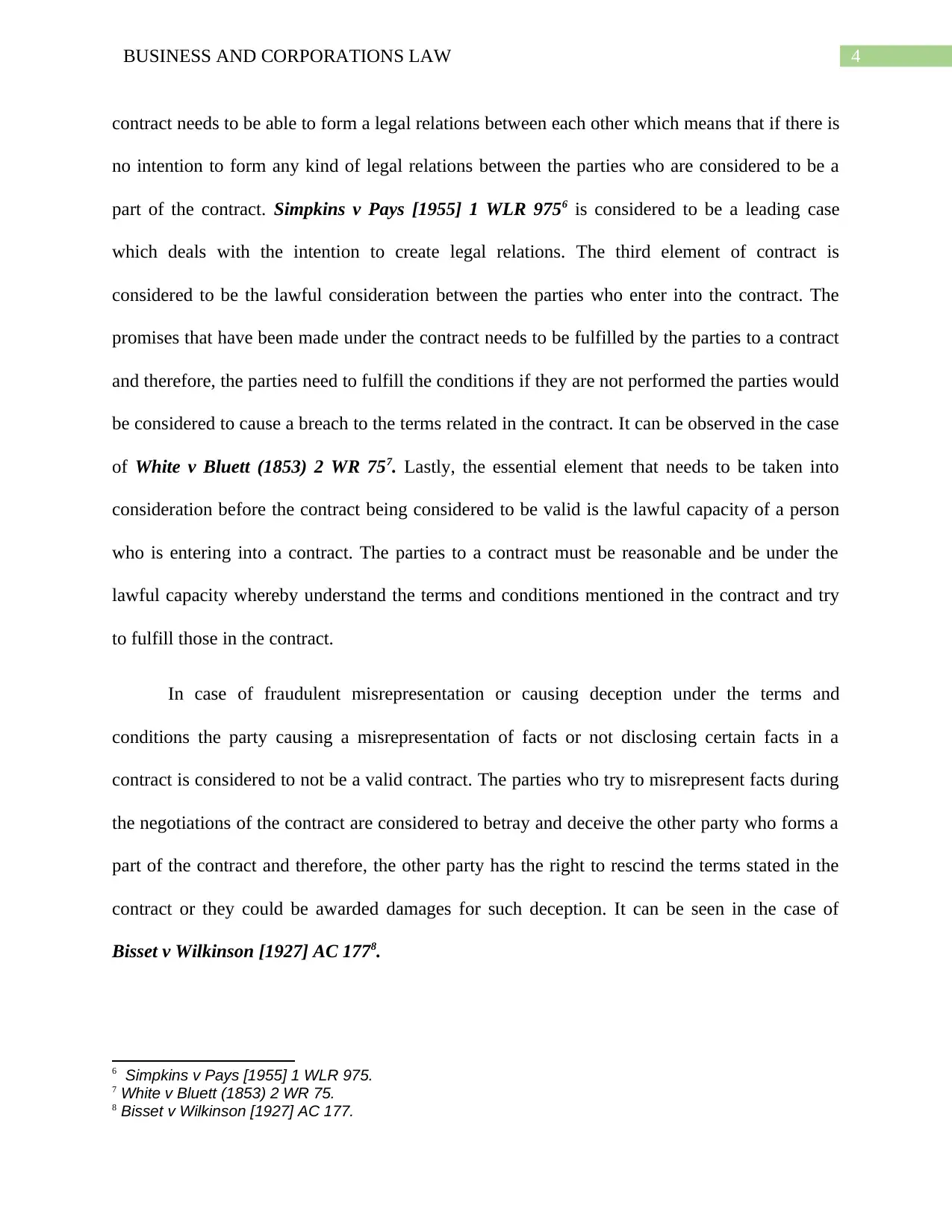
4BUSINESS AND CORPORATIONS LAW
contract needs to be able to form a legal relations between each other which means that if there is
no intention to form any kind of legal relations between the parties who are considered to be a
part of the contract. Simpkins v Pays [1955] 1 WLR 9756 is considered to be a leading case
which deals with the intention to create legal relations. The third element of contract is
considered to be the lawful consideration between the parties who enter into the contract. The
promises that have been made under the contract needs to be fulfilled by the parties to a contract
and therefore, the parties need to fulfill the conditions if they are not performed the parties would
be considered to cause a breach to the terms related in the contract. It can be observed in the case
of White v Bluett (1853) 2 WR 757. Lastly, the essential element that needs to be taken into
consideration before the contract being considered to be valid is the lawful capacity of a person
who is entering into a contract. The parties to a contract must be reasonable and be under the
lawful capacity whereby understand the terms and conditions mentioned in the contract and try
to fulfill those in the contract.
In case of fraudulent misrepresentation or causing deception under the terms and
conditions the party causing a misrepresentation of facts or not disclosing certain facts in a
contract is considered to not be a valid contract. The parties who try to misrepresent facts during
the negotiations of the contract are considered to betray and deceive the other party who forms a
part of the contract and therefore, the other party has the right to rescind the terms stated in the
contract or they could be awarded damages for such deception. It can be seen in the case of
Bisset v Wilkinson [1927] AC 1778.
6 Simpkins v Pays [1955] 1 WLR 975.
7 White v Bluett (1853) 2 WR 75.
8 Bisset v Wilkinson [1927] AC 177.
contract needs to be able to form a legal relations between each other which means that if there is
no intention to form any kind of legal relations between the parties who are considered to be a
part of the contract. Simpkins v Pays [1955] 1 WLR 9756 is considered to be a leading case
which deals with the intention to create legal relations. The third element of contract is
considered to be the lawful consideration between the parties who enter into the contract. The
promises that have been made under the contract needs to be fulfilled by the parties to a contract
and therefore, the parties need to fulfill the conditions if they are not performed the parties would
be considered to cause a breach to the terms related in the contract. It can be observed in the case
of White v Bluett (1853) 2 WR 757. Lastly, the essential element that needs to be taken into
consideration before the contract being considered to be valid is the lawful capacity of a person
who is entering into a contract. The parties to a contract must be reasonable and be under the
lawful capacity whereby understand the terms and conditions mentioned in the contract and try
to fulfill those in the contract.
In case of fraudulent misrepresentation or causing deception under the terms and
conditions the party causing a misrepresentation of facts or not disclosing certain facts in a
contract is considered to not be a valid contract. The parties who try to misrepresent facts during
the negotiations of the contract are considered to betray and deceive the other party who forms a
part of the contract and therefore, the other party has the right to rescind the terms stated in the
contract or they could be awarded damages for such deception. It can be seen in the case of
Bisset v Wilkinson [1927] AC 1778.
6 Simpkins v Pays [1955] 1 WLR 975.
7 White v Bluett (1853) 2 WR 75.
8 Bisset v Wilkinson [1927] AC 177.
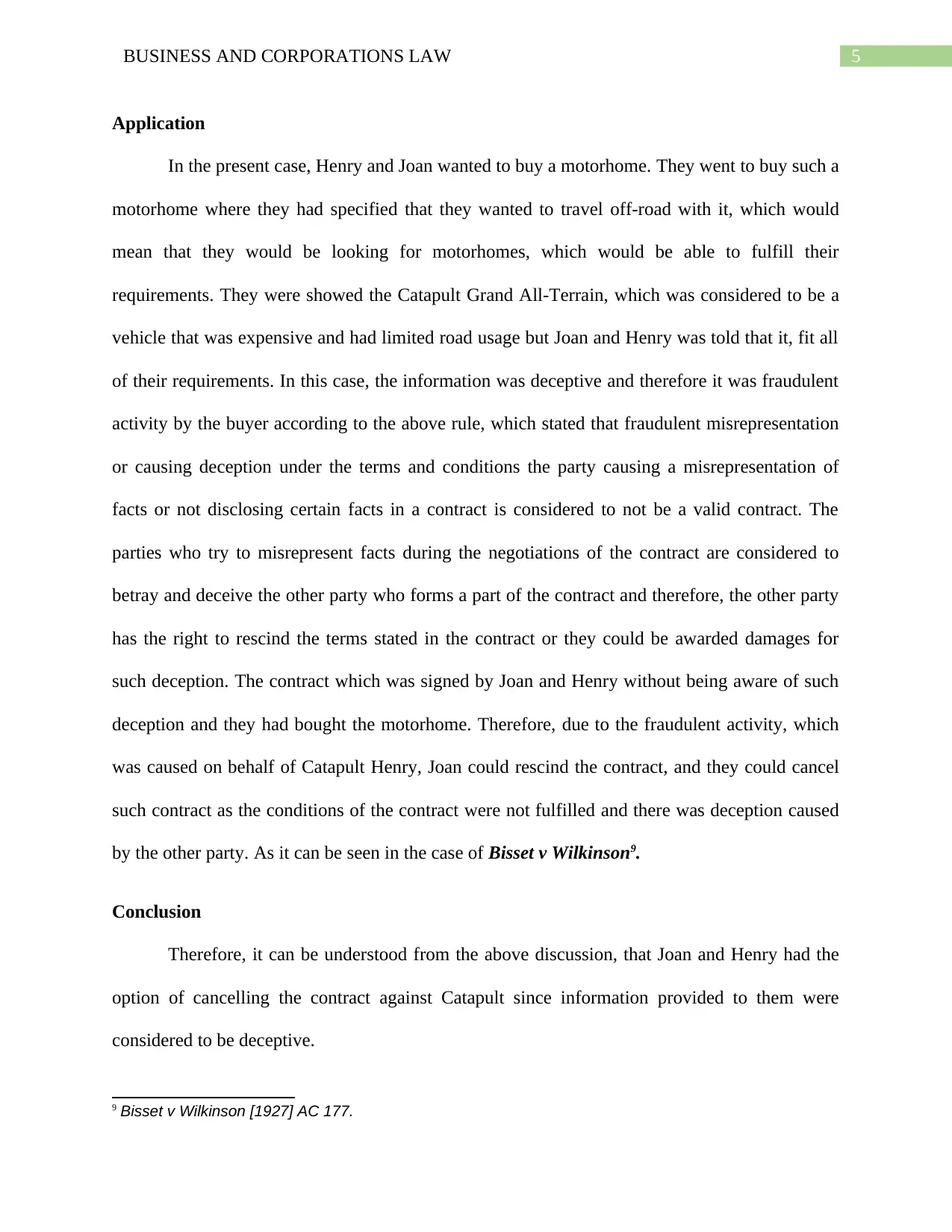
5BUSINESS AND CORPORATIONS LAW
Application
In the present case, Henry and Joan wanted to buy a motorhome. They went to buy such a
motorhome where they had specified that they wanted to travel off-road with it, which would
mean that they would be looking for motorhomes, which would be able to fulfill their
requirements. They were showed the Catapult Grand All-Terrain, which was considered to be a
vehicle that was expensive and had limited road usage but Joan and Henry was told that it, fit all
of their requirements. In this case, the information was deceptive and therefore it was fraudulent
activity by the buyer according to the above rule, which stated that fraudulent misrepresentation
or causing deception under the terms and conditions the party causing a misrepresentation of
facts or not disclosing certain facts in a contract is considered to not be a valid contract. The
parties who try to misrepresent facts during the negotiations of the contract are considered to
betray and deceive the other party who forms a part of the contract and therefore, the other party
has the right to rescind the terms stated in the contract or they could be awarded damages for
such deception. The contract which was signed by Joan and Henry without being aware of such
deception and they had bought the motorhome. Therefore, due to the fraudulent activity, which
was caused on behalf of Catapult Henry, Joan could rescind the contract, and they could cancel
such contract as the conditions of the contract were not fulfilled and there was deception caused
by the other party. As it can be seen in the case of Bisset v Wilkinson9.
Conclusion
Therefore, it can be understood from the above discussion, that Joan and Henry had the
option of cancelling the contract against Catapult since information provided to them were
considered to be deceptive.
9 Bisset v Wilkinson [1927] AC 177.
Application
In the present case, Henry and Joan wanted to buy a motorhome. They went to buy such a
motorhome where they had specified that they wanted to travel off-road with it, which would
mean that they would be looking for motorhomes, which would be able to fulfill their
requirements. They were showed the Catapult Grand All-Terrain, which was considered to be a
vehicle that was expensive and had limited road usage but Joan and Henry was told that it, fit all
of their requirements. In this case, the information was deceptive and therefore it was fraudulent
activity by the buyer according to the above rule, which stated that fraudulent misrepresentation
or causing deception under the terms and conditions the party causing a misrepresentation of
facts or not disclosing certain facts in a contract is considered to not be a valid contract. The
parties who try to misrepresent facts during the negotiations of the contract are considered to
betray and deceive the other party who forms a part of the contract and therefore, the other party
has the right to rescind the terms stated in the contract or they could be awarded damages for
such deception. The contract which was signed by Joan and Henry without being aware of such
deception and they had bought the motorhome. Therefore, due to the fraudulent activity, which
was caused on behalf of Catapult Henry, Joan could rescind the contract, and they could cancel
such contract as the conditions of the contract were not fulfilled and there was deception caused
by the other party. As it can be seen in the case of Bisset v Wilkinson9.
Conclusion
Therefore, it can be understood from the above discussion, that Joan and Henry had the
option of cancelling the contract against Catapult since information provided to them were
considered to be deceptive.
9 Bisset v Wilkinson [1927] AC 177.
⊘ This is a preview!⊘
Do you want full access?
Subscribe today to unlock all pages.

Trusted by 1+ million students worldwide
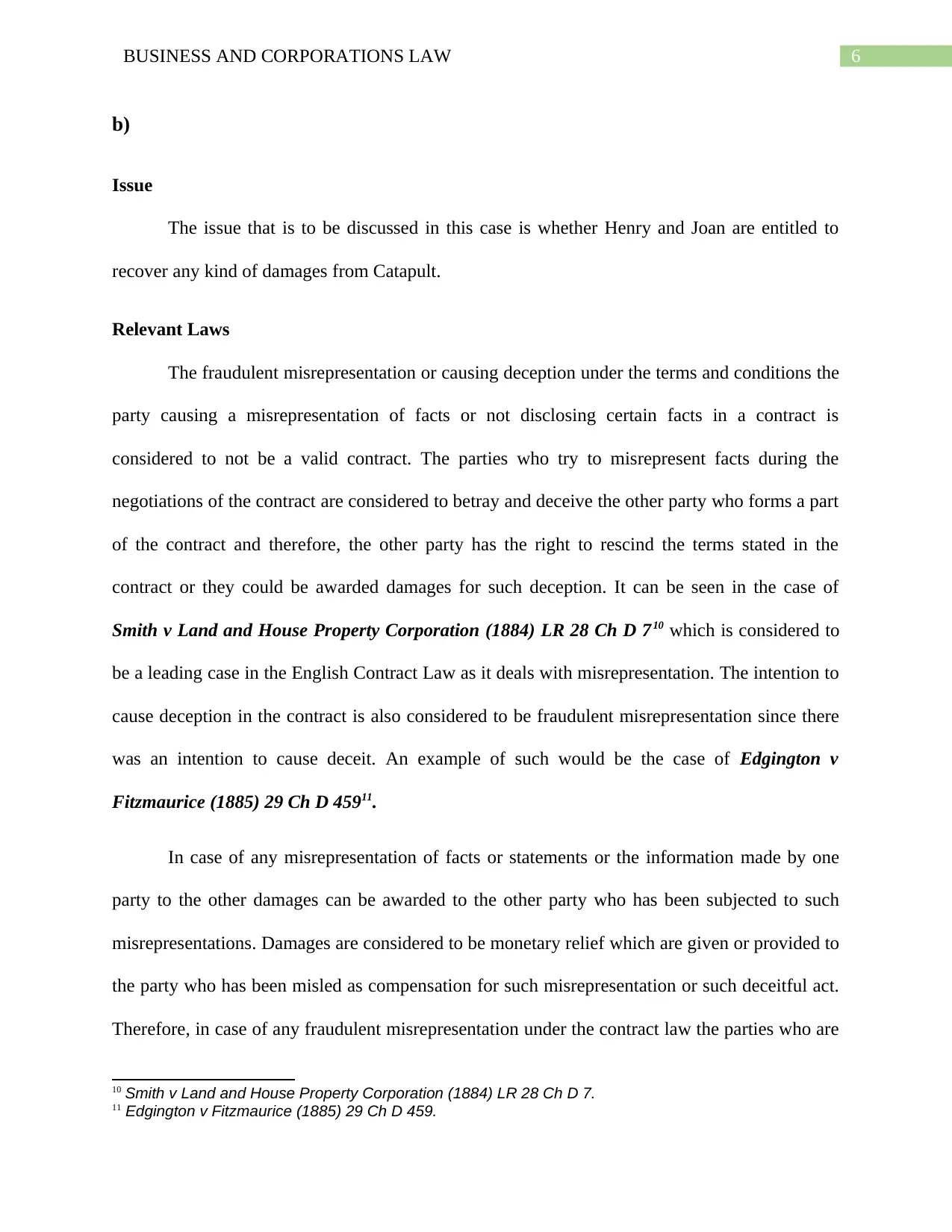
6BUSINESS AND CORPORATIONS LAW
b)
Issue
The issue that is to be discussed in this case is whether Henry and Joan are entitled to
recover any kind of damages from Catapult.
Relevant Laws
The fraudulent misrepresentation or causing deception under the terms and conditions the
party causing a misrepresentation of facts or not disclosing certain facts in a contract is
considered to not be a valid contract. The parties who try to misrepresent facts during the
negotiations of the contract are considered to betray and deceive the other party who forms a part
of the contract and therefore, the other party has the right to rescind the terms stated in the
contract or they could be awarded damages for such deception. It can be seen in the case of
Smith v Land and House Property Corporation (1884) LR 28 Ch D 710 which is considered to
be a leading case in the English Contract Law as it deals with misrepresentation. The intention to
cause deception in the contract is also considered to be fraudulent misrepresentation since there
was an intention to cause deceit. An example of such would be the case of Edgington v
Fitzmaurice (1885) 29 Ch D 45911.
In case of any misrepresentation of facts or statements or the information made by one
party to the other damages can be awarded to the other party who has been subjected to such
misrepresentations. Damages are considered to be monetary relief which are given or provided to
the party who has been misled as compensation for such misrepresentation or such deceitful act.
Therefore, in case of any fraudulent misrepresentation under the contract law the parties who are
10 Smith v Land and House Property Corporation (1884) LR 28 Ch D 7.
11 Edgington v Fitzmaurice (1885) 29 Ch D 459.
b)
Issue
The issue that is to be discussed in this case is whether Henry and Joan are entitled to
recover any kind of damages from Catapult.
Relevant Laws
The fraudulent misrepresentation or causing deception under the terms and conditions the
party causing a misrepresentation of facts or not disclosing certain facts in a contract is
considered to not be a valid contract. The parties who try to misrepresent facts during the
negotiations of the contract are considered to betray and deceive the other party who forms a part
of the contract and therefore, the other party has the right to rescind the terms stated in the
contract or they could be awarded damages for such deception. It can be seen in the case of
Smith v Land and House Property Corporation (1884) LR 28 Ch D 710 which is considered to
be a leading case in the English Contract Law as it deals with misrepresentation. The intention to
cause deception in the contract is also considered to be fraudulent misrepresentation since there
was an intention to cause deceit. An example of such would be the case of Edgington v
Fitzmaurice (1885) 29 Ch D 45911.
In case of any misrepresentation of facts or statements or the information made by one
party to the other damages can be awarded to the other party who has been subjected to such
misrepresentations. Damages are considered to be monetary relief which are given or provided to
the party who has been misled as compensation for such misrepresentation or such deceitful act.
Therefore, in case of any fraudulent misrepresentation under the contract law the parties who are
10 Smith v Land and House Property Corporation (1884) LR 28 Ch D 7.
11 Edgington v Fitzmaurice (1885) 29 Ch D 459.
Paraphrase This Document
Need a fresh take? Get an instant paraphrase of this document with our AI Paraphraser
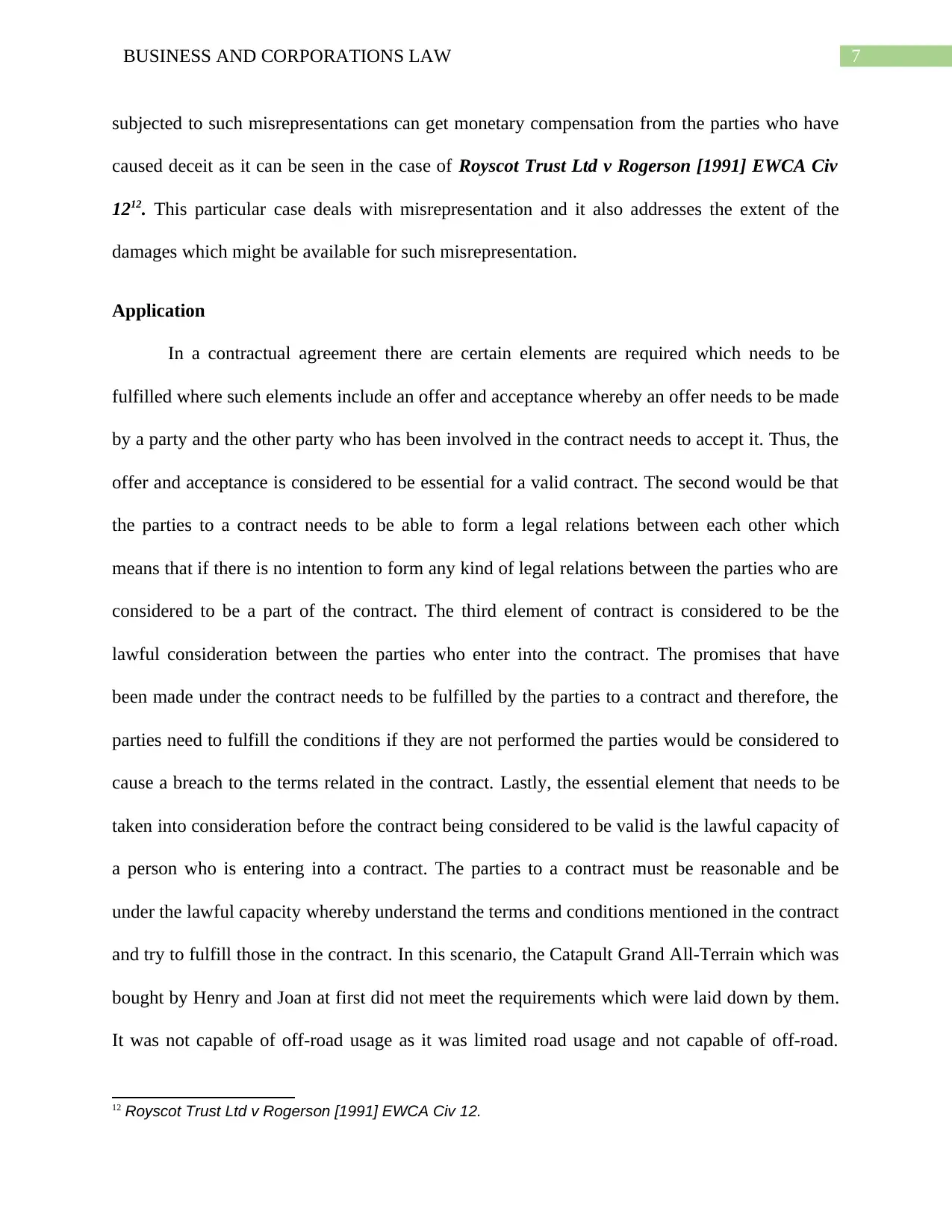
7BUSINESS AND CORPORATIONS LAW
subjected to such misrepresentations can get monetary compensation from the parties who have
caused deceit as it can be seen in the case of Royscot Trust Ltd v Rogerson [1991] EWCA Civ
1212. This particular case deals with misrepresentation and it also addresses the extent of the
damages which might be available for such misrepresentation.
Application
In a contractual agreement there are certain elements are required which needs to be
fulfilled where such elements include an offer and acceptance whereby an offer needs to be made
by a party and the other party who has been involved in the contract needs to accept it. Thus, the
offer and acceptance is considered to be essential for a valid contract. The second would be that
the parties to a contract needs to be able to form a legal relations between each other which
means that if there is no intention to form any kind of legal relations between the parties who are
considered to be a part of the contract. The third element of contract is considered to be the
lawful consideration between the parties who enter into the contract. The promises that have
been made under the contract needs to be fulfilled by the parties to a contract and therefore, the
parties need to fulfill the conditions if they are not performed the parties would be considered to
cause a breach to the terms related in the contract. Lastly, the essential element that needs to be
taken into consideration before the contract being considered to be valid is the lawful capacity of
a person who is entering into a contract. The parties to a contract must be reasonable and be
under the lawful capacity whereby understand the terms and conditions mentioned in the contract
and try to fulfill those in the contract. In this scenario, the Catapult Grand All-Terrain which was
bought by Henry and Joan at first did not meet the requirements which were laid down by them.
It was not capable of off-road usage as it was limited road usage and not capable of off-road.
12 Royscot Trust Ltd v Rogerson [1991] EWCA Civ 12.
subjected to such misrepresentations can get monetary compensation from the parties who have
caused deceit as it can be seen in the case of Royscot Trust Ltd v Rogerson [1991] EWCA Civ
1212. This particular case deals with misrepresentation and it also addresses the extent of the
damages which might be available for such misrepresentation.
Application
In a contractual agreement there are certain elements are required which needs to be
fulfilled where such elements include an offer and acceptance whereby an offer needs to be made
by a party and the other party who has been involved in the contract needs to accept it. Thus, the
offer and acceptance is considered to be essential for a valid contract. The second would be that
the parties to a contract needs to be able to form a legal relations between each other which
means that if there is no intention to form any kind of legal relations between the parties who are
considered to be a part of the contract. The third element of contract is considered to be the
lawful consideration between the parties who enter into the contract. The promises that have
been made under the contract needs to be fulfilled by the parties to a contract and therefore, the
parties need to fulfill the conditions if they are not performed the parties would be considered to
cause a breach to the terms related in the contract. Lastly, the essential element that needs to be
taken into consideration before the contract being considered to be valid is the lawful capacity of
a person who is entering into a contract. The parties to a contract must be reasonable and be
under the lawful capacity whereby understand the terms and conditions mentioned in the contract
and try to fulfill those in the contract. In this scenario, the Catapult Grand All-Terrain which was
bought by Henry and Joan at first did not meet the requirements which were laid down by them.
It was not capable of off-road usage as it was limited road usage and not capable of off-road.
12 Royscot Trust Ltd v Rogerson [1991] EWCA Civ 12.
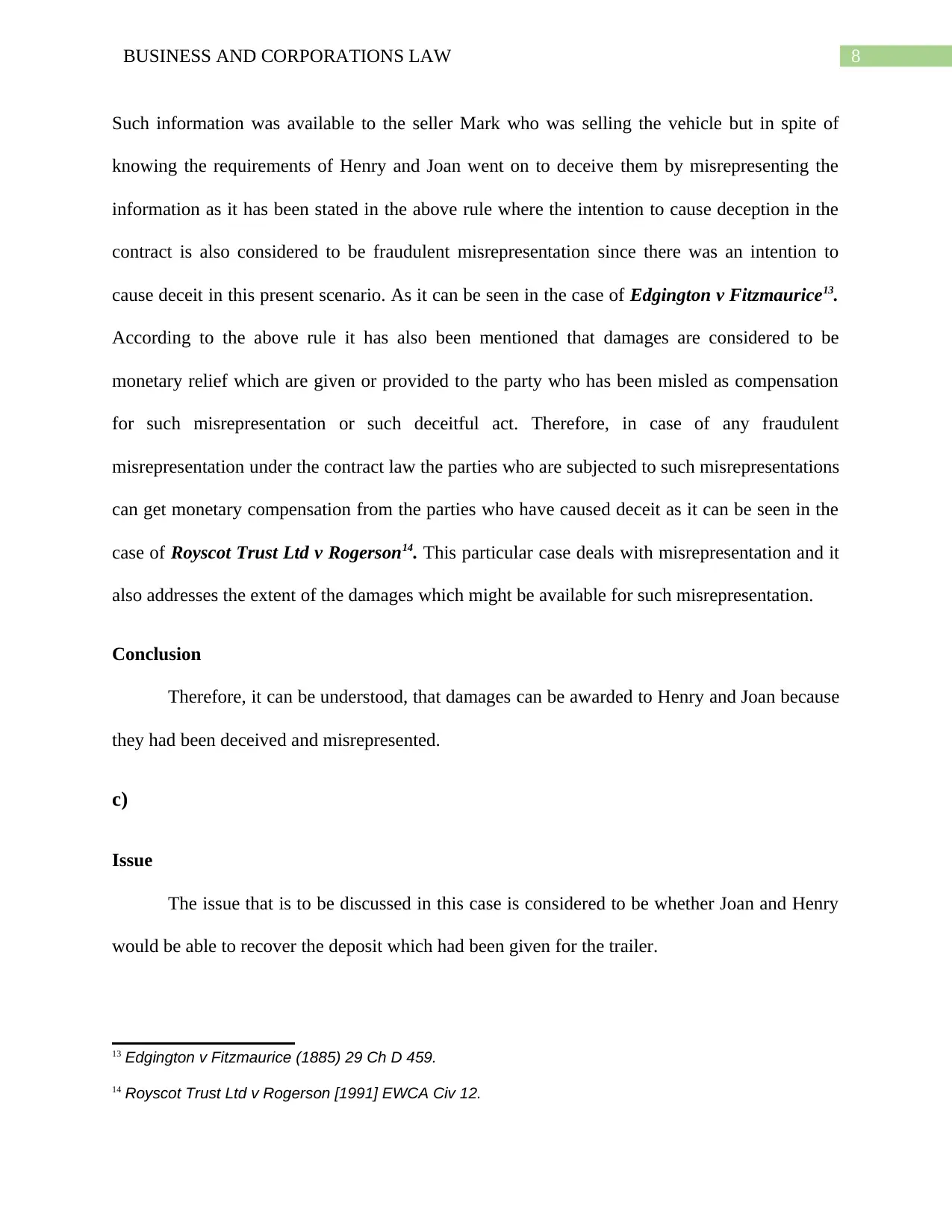
8BUSINESS AND CORPORATIONS LAW
Such information was available to the seller Mark who was selling the vehicle but in spite of
knowing the requirements of Henry and Joan went on to deceive them by misrepresenting the
information as it has been stated in the above rule where the intention to cause deception in the
contract is also considered to be fraudulent misrepresentation since there was an intention to
cause deceit in this present scenario. As it can be seen in the case of Edgington v Fitzmaurice13.
According to the above rule it has also been mentioned that damages are considered to be
monetary relief which are given or provided to the party who has been misled as compensation
for such misrepresentation or such deceitful act. Therefore, in case of any fraudulent
misrepresentation under the contract law the parties who are subjected to such misrepresentations
can get monetary compensation from the parties who have caused deceit as it can be seen in the
case of Royscot Trust Ltd v Rogerson14. This particular case deals with misrepresentation and it
also addresses the extent of the damages which might be available for such misrepresentation.
Conclusion
Therefore, it can be understood, that damages can be awarded to Henry and Joan because
they had been deceived and misrepresented.
c)
Issue
The issue that is to be discussed in this case is considered to be whether Joan and Henry
would be able to recover the deposit which had been given for the trailer.
13 Edgington v Fitzmaurice (1885) 29 Ch D 459.
14 Royscot Trust Ltd v Rogerson [1991] EWCA Civ 12.
Such information was available to the seller Mark who was selling the vehicle but in spite of
knowing the requirements of Henry and Joan went on to deceive them by misrepresenting the
information as it has been stated in the above rule where the intention to cause deception in the
contract is also considered to be fraudulent misrepresentation since there was an intention to
cause deceit in this present scenario. As it can be seen in the case of Edgington v Fitzmaurice13.
According to the above rule it has also been mentioned that damages are considered to be
monetary relief which are given or provided to the party who has been misled as compensation
for such misrepresentation or such deceitful act. Therefore, in case of any fraudulent
misrepresentation under the contract law the parties who are subjected to such misrepresentations
can get monetary compensation from the parties who have caused deceit as it can be seen in the
case of Royscot Trust Ltd v Rogerson14. This particular case deals with misrepresentation and it
also addresses the extent of the damages which might be available for such misrepresentation.
Conclusion
Therefore, it can be understood, that damages can be awarded to Henry and Joan because
they had been deceived and misrepresented.
c)
Issue
The issue that is to be discussed in this case is considered to be whether Joan and Henry
would be able to recover the deposit which had been given for the trailer.
13 Edgington v Fitzmaurice (1885) 29 Ch D 459.
14 Royscot Trust Ltd v Rogerson [1991] EWCA Civ 12.
⊘ This is a preview!⊘
Do you want full access?
Subscribe today to unlock all pages.

Trusted by 1+ million students worldwide
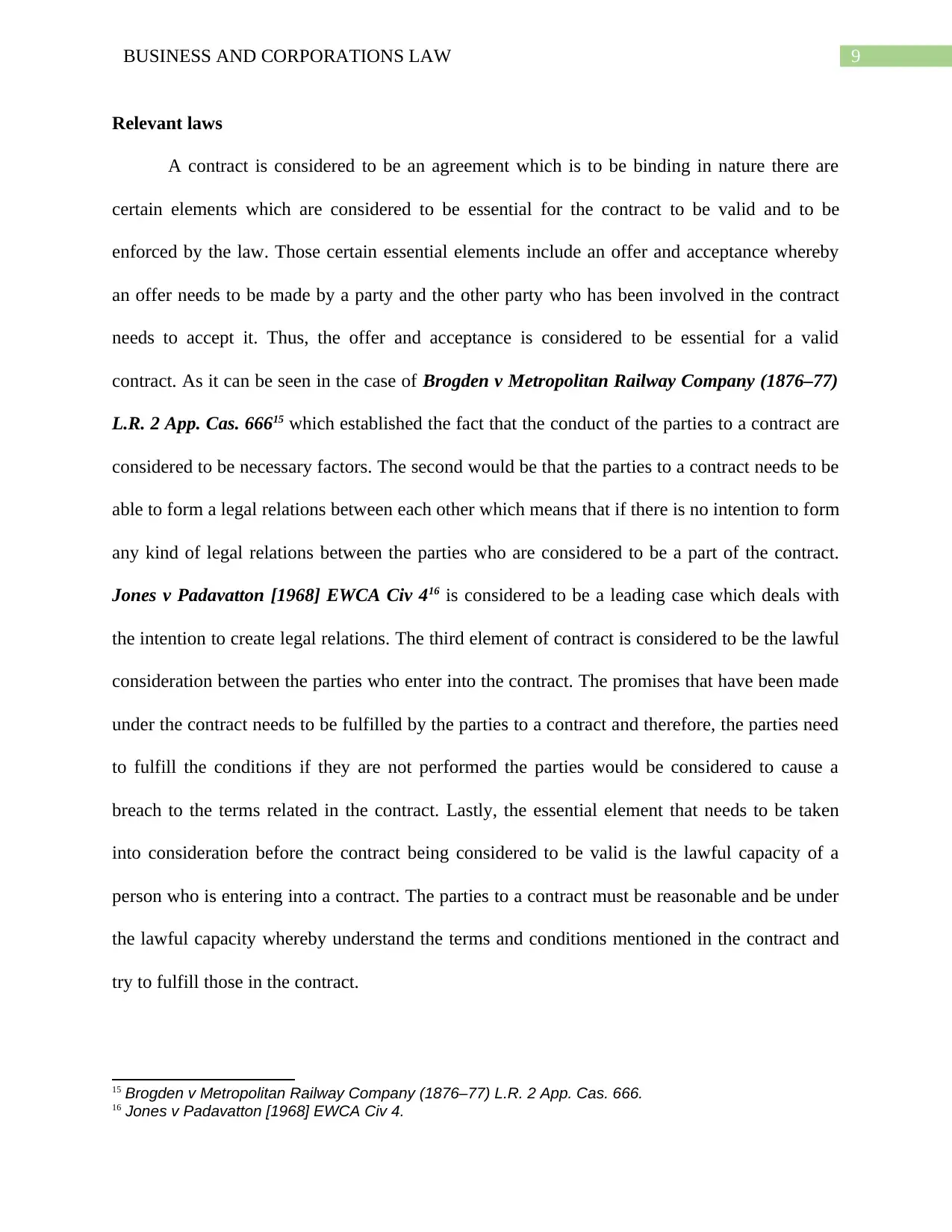
9BUSINESS AND CORPORATIONS LAW
Relevant laws
A contract is considered to be an agreement which is to be binding in nature there are
certain elements which are considered to be essential for the contract to be valid and to be
enforced by the law. Those certain essential elements include an offer and acceptance whereby
an offer needs to be made by a party and the other party who has been involved in the contract
needs to accept it. Thus, the offer and acceptance is considered to be essential for a valid
contract. As it can be seen in the case of Brogden v Metropolitan Railway Company (1876–77)
L.R. 2 App. Cas. 66615 which established the fact that the conduct of the parties to a contract are
considered to be necessary factors. The second would be that the parties to a contract needs to be
able to form a legal relations between each other which means that if there is no intention to form
any kind of legal relations between the parties who are considered to be a part of the contract.
Jones v Padavatton [1968] EWCA Civ 416 is considered to be a leading case which deals with
the intention to create legal relations. The third element of contract is considered to be the lawful
consideration between the parties who enter into the contract. The promises that have been made
under the contract needs to be fulfilled by the parties to a contract and therefore, the parties need
to fulfill the conditions if they are not performed the parties would be considered to cause a
breach to the terms related in the contract. Lastly, the essential element that needs to be taken
into consideration before the contract being considered to be valid is the lawful capacity of a
person who is entering into a contract. The parties to a contract must be reasonable and be under
the lawful capacity whereby understand the terms and conditions mentioned in the contract and
try to fulfill those in the contract.
15 Brogden v Metropolitan Railway Company (1876–77) L.R. 2 App. Cas. 666.
16 Jones v Padavatton [1968] EWCA Civ 4.
Relevant laws
A contract is considered to be an agreement which is to be binding in nature there are
certain elements which are considered to be essential for the contract to be valid and to be
enforced by the law. Those certain essential elements include an offer and acceptance whereby
an offer needs to be made by a party and the other party who has been involved in the contract
needs to accept it. Thus, the offer and acceptance is considered to be essential for a valid
contract. As it can be seen in the case of Brogden v Metropolitan Railway Company (1876–77)
L.R. 2 App. Cas. 66615 which established the fact that the conduct of the parties to a contract are
considered to be necessary factors. The second would be that the parties to a contract needs to be
able to form a legal relations between each other which means that if there is no intention to form
any kind of legal relations between the parties who are considered to be a part of the contract.
Jones v Padavatton [1968] EWCA Civ 416 is considered to be a leading case which deals with
the intention to create legal relations. The third element of contract is considered to be the lawful
consideration between the parties who enter into the contract. The promises that have been made
under the contract needs to be fulfilled by the parties to a contract and therefore, the parties need
to fulfill the conditions if they are not performed the parties would be considered to cause a
breach to the terms related in the contract. Lastly, the essential element that needs to be taken
into consideration before the contract being considered to be valid is the lawful capacity of a
person who is entering into a contract. The parties to a contract must be reasonable and be under
the lawful capacity whereby understand the terms and conditions mentioned in the contract and
try to fulfill those in the contract.
15 Brogden v Metropolitan Railway Company (1876–77) L.R. 2 App. Cas. 666.
16 Jones v Padavatton [1968] EWCA Civ 4.
Paraphrase This Document
Need a fresh take? Get an instant paraphrase of this document with our AI Paraphraser
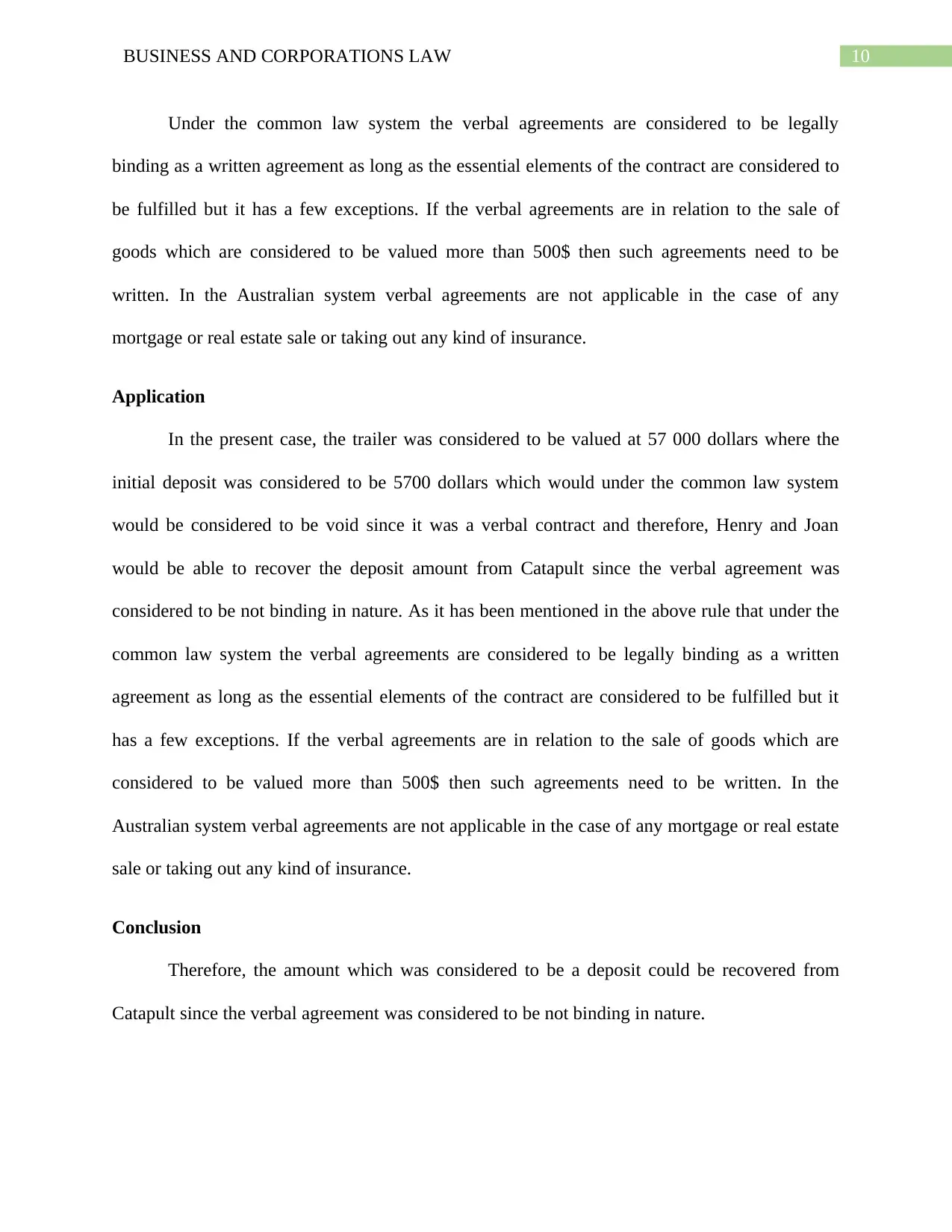
10BUSINESS AND CORPORATIONS LAW
Under the common law system the verbal agreements are considered to be legally
binding as a written agreement as long as the essential elements of the contract are considered to
be fulfilled but it has a few exceptions. If the verbal agreements are in relation to the sale of
goods which are considered to be valued more than 500$ then such agreements need to be
written. In the Australian system verbal agreements are not applicable in the case of any
mortgage or real estate sale or taking out any kind of insurance.
Application
In the present case, the trailer was considered to be valued at 57 000 dollars where the
initial deposit was considered to be 5700 dollars which would under the common law system
would be considered to be void since it was a verbal contract and therefore, Henry and Joan
would be able to recover the deposit amount from Catapult since the verbal agreement was
considered to be not binding in nature. As it has been mentioned in the above rule that under the
common law system the verbal agreements are considered to be legally binding as a written
agreement as long as the essential elements of the contract are considered to be fulfilled but it
has a few exceptions. If the verbal agreements are in relation to the sale of goods which are
considered to be valued more than 500$ then such agreements need to be written. In the
Australian system verbal agreements are not applicable in the case of any mortgage or real estate
sale or taking out any kind of insurance.
Conclusion
Therefore, the amount which was considered to be a deposit could be recovered from
Catapult since the verbal agreement was considered to be not binding in nature.
Under the common law system the verbal agreements are considered to be legally
binding as a written agreement as long as the essential elements of the contract are considered to
be fulfilled but it has a few exceptions. If the verbal agreements are in relation to the sale of
goods which are considered to be valued more than 500$ then such agreements need to be
written. In the Australian system verbal agreements are not applicable in the case of any
mortgage or real estate sale or taking out any kind of insurance.
Application
In the present case, the trailer was considered to be valued at 57 000 dollars where the
initial deposit was considered to be 5700 dollars which would under the common law system
would be considered to be void since it was a verbal contract and therefore, Henry and Joan
would be able to recover the deposit amount from Catapult since the verbal agreement was
considered to be not binding in nature. As it has been mentioned in the above rule that under the
common law system the verbal agreements are considered to be legally binding as a written
agreement as long as the essential elements of the contract are considered to be fulfilled but it
has a few exceptions. If the verbal agreements are in relation to the sale of goods which are
considered to be valued more than 500$ then such agreements need to be written. In the
Australian system verbal agreements are not applicable in the case of any mortgage or real estate
sale or taking out any kind of insurance.
Conclusion
Therefore, the amount which was considered to be a deposit could be recovered from
Catapult since the verbal agreement was considered to be not binding in nature.
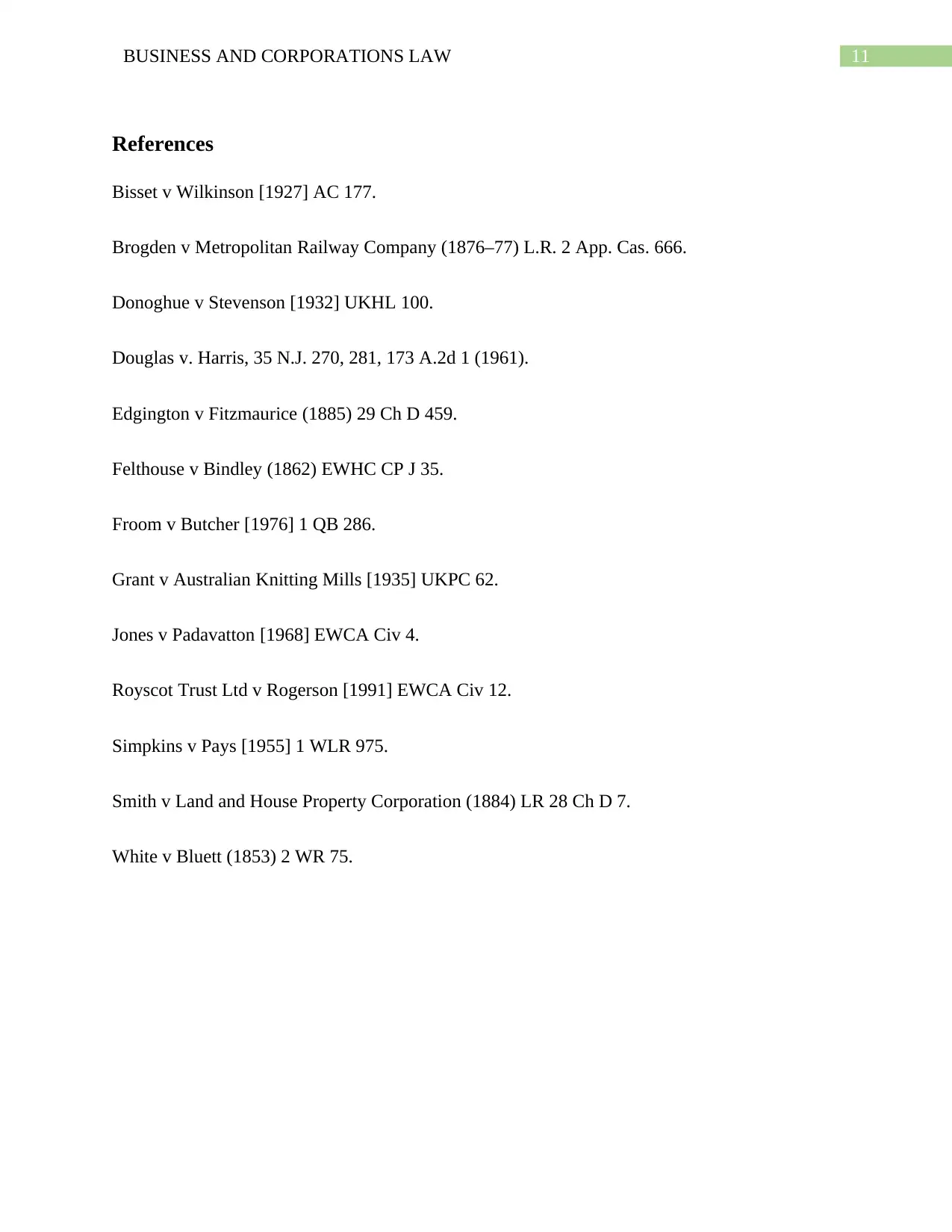
11BUSINESS AND CORPORATIONS LAW
References
Bisset v Wilkinson [1927] AC 177.
Brogden v Metropolitan Railway Company (1876–77) L.R. 2 App. Cas. 666.
Donoghue v Stevenson [1932] UKHL 100.
Douglas v. Harris, 35 N.J. 270, 281, 173 A.2d 1 (1961).
Edgington v Fitzmaurice (1885) 29 Ch D 459.
Felthouse v Bindley (1862) EWHC CP J 35.
Froom v Butcher [1976] 1 QB 286.
Grant v Australian Knitting Mills [1935] UKPC 62.
Jones v Padavatton [1968] EWCA Civ 4.
Royscot Trust Ltd v Rogerson [1991] EWCA Civ 12.
Simpkins v Pays [1955] 1 WLR 975.
Smith v Land and House Property Corporation (1884) LR 28 Ch D 7.
White v Bluett (1853) 2 WR 75.
References
Bisset v Wilkinson [1927] AC 177.
Brogden v Metropolitan Railway Company (1876–77) L.R. 2 App. Cas. 666.
Donoghue v Stevenson [1932] UKHL 100.
Douglas v. Harris, 35 N.J. 270, 281, 173 A.2d 1 (1961).
Edgington v Fitzmaurice (1885) 29 Ch D 459.
Felthouse v Bindley (1862) EWHC CP J 35.
Froom v Butcher [1976] 1 QB 286.
Grant v Australian Knitting Mills [1935] UKPC 62.
Jones v Padavatton [1968] EWCA Civ 4.
Royscot Trust Ltd v Rogerson [1991] EWCA Civ 12.
Simpkins v Pays [1955] 1 WLR 975.
Smith v Land and House Property Corporation (1884) LR 28 Ch D 7.
White v Bluett (1853) 2 WR 75.
⊘ This is a preview!⊘
Do you want full access?
Subscribe today to unlock all pages.

Trusted by 1+ million students worldwide
1 out of 13
Related Documents
Your All-in-One AI-Powered Toolkit for Academic Success.
+13062052269
info@desklib.com
Available 24*7 on WhatsApp / Email
![[object Object]](/_next/static/media/star-bottom.7253800d.svg)
Unlock your academic potential
Copyright © 2020–2025 A2Z Services. All Rights Reserved. Developed and managed by ZUCOL.




